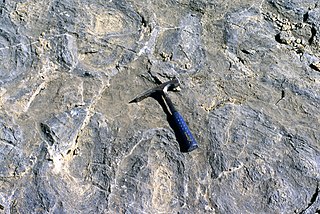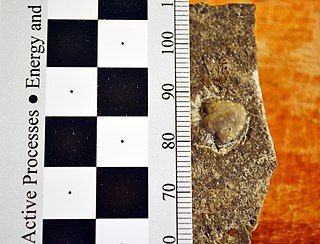 W
WThe Cambrian Bright Angel Shale is the middle layer of the three member Tonto Group geologic feature. The 3-rock Tonto section famously sits upon the Great Unconformity because of the highly resistant cliffs of the base layer, vertical Tapeats Sandstone cliffs.
 W
WThe Buen Formation is a geologic formation and Lagerstätte in the north of Greenland. The shale preserves fossils dating back to the Early Cambrian period.
 W
WThe Burgess Shale is a fossil-bearing deposit exposed in the Canadian Rockies of British Columbia, Canada. It is famous for the exceptional preservation of the soft parts of its fossils. At 508 million years old, it is one of the earliest fossil beds containing soft-part imprints.
 W
WThe Campito Formation is a geologic formation in Nevada. It preserves fossils dating back to the Cambrian period.
 W
WThe Carrara Formation is a geologic formation in Nevada. It preserves fossils dating back to the Cambrian period.
 W
WThe Deadwood Formation is a geologic formation of the Williston Basin and Western Canada Sedimentary Basin. It is present in parts of North and South Dakota and Montana in the United States, and in parts of Alberta, Saskatchewan, and southwestern corner of Manitoba in Canada. It is of Late Cambrian to Early Ordovician age and was named for exposures in Whitewood Creek near Deadwood, South Dakota. It is a significant aquifer in some areas, and its conglomerates yielded significant quantities of gold in the Black Hills of South Dakota.
 W
WThe Eau Claire Formation is a geologic formation in the north central United States. It preserves trilobite fossils from the Cambrian Period.
 W
WThe Gros Ventre Formation is a geologic formation in Wyoming, USA. It preserves fossils dating back to the Cambrian period. The Gros Ventre consists of three main members; the Wolsey Shale, the Death Canyon Limestone, and the Park Shale.
 W
WThe Langston Formation is a geologic formation in Idaho and Utah. It preserves fossils dating back to the Cambrian period. The formation is composed of bluish-gray limestone, weathering to a buff color, often with rounded edges.
 W
WThe Mount Cap Formation is a geologic formation exposed in the Mackenzie Mountains, northern Canada. It was deposited in a shallow shelf setting in the late Early Cambrian, and contains an array of Burgess Shale-type microfossils that have been recovered by acid maceration.
 W
WThe Orr Formation is a geologic formation in Utah. It preserves fossils dating back to the Cambrian period.
 W
WThe Pilgrim Formation is a geologic formation in Montana. It preserves fossils dating back to the Cambrian period.
 W
WThe Snowy Range Formation is a geologic formation in Montana. It preserves fossils dating back to the Cambrian period.
 W
WThe Spence Shale is the middle member of the Langston Formation in southeastern Idaho and northeastern Utah. It is exposed in the Bear River Range, the Wasatch Range and the Wellsville Mountains. It is known for its abundant Cambrian trilobites and the preservation of Burgess Shale-type fossils.
 W
WThe Stephen Formation is a geologic formation exposed in the Canadian Rockies of British Columbia and Alberta, on the western edge of the Western Canada Sedimentary Basin. It consists of shale, thin-bedded limestone, and siltstone that was deposited during Middle Cambrian time. It is famous for the exceptional preservation of soft-bodied fossils: the Burgess Shale biota. The formation overlies the Cathedral escarpment, a submarine cliff; consequently it is divided into two quite separate parts, the 'thin' sequence deposited in the shallower waters atop the escarpment, and the 'thick' sequence deposited in the deeper waters beyond the cliff. Because the 'thick' Stephen Formation represents a distinct lithofacies, some authors suggest it warrants its own name, and dub it the Burgess Shale Formation. The stratigraphy of the Thin Stephen Formation has not been subject to extensive study, so except where explicitly mentioned this article applies mainly to the Thick Stephen Formation.
 W
WThe Whipple Cave Formation is a geologic formation in Nevada. It preserves fossils dating back to the Cambrian period.
 W
WThe Wolsey Shale is a geologic formation in Montana. It preserves fossils dating back to the Cambrian period.